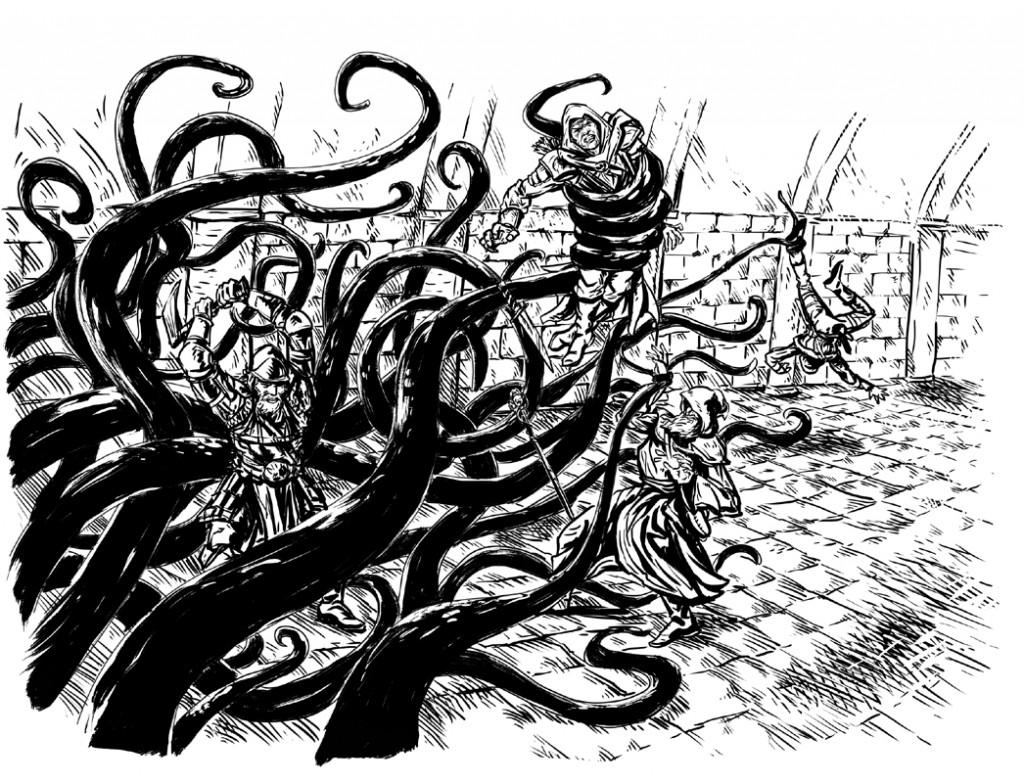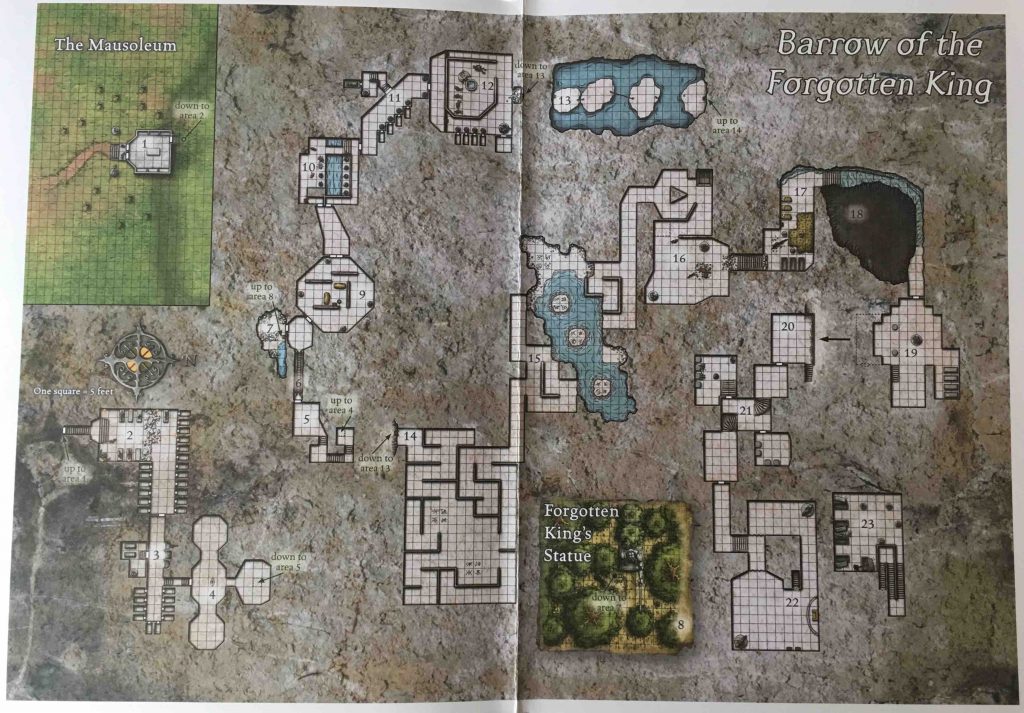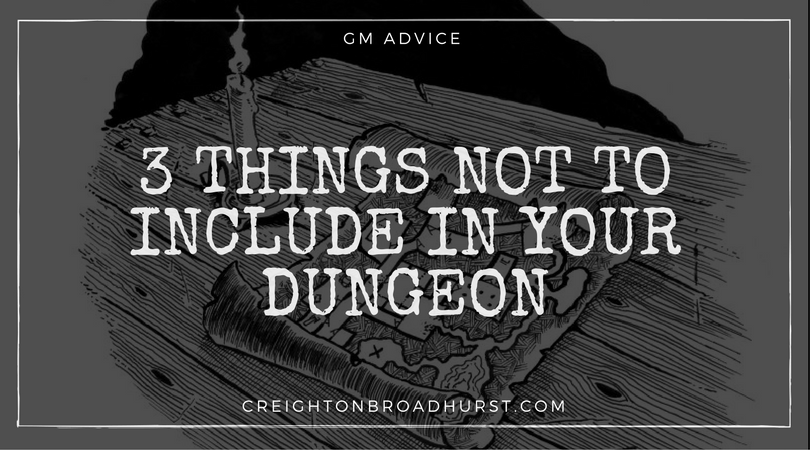I’ve previously written loads of articles about good dungeon design. However, I haven’t thus far listed the things you absolutely should not include in your dungeons.

Here—in no particular order—are three things you should avoid in your dungeon design.
Unavoidable, Unkillable Monsters
There’s nothing wrong with having unavoidable encounters in a dungeon. (Often the “boss” encounters falls into this category). I’m also not particularly fussed about the inclusion of unkillable or virtually unkillable opponents (balance isn’t all its cracked up to be, after all and there is always someone tougher than yourself).
However, unavoidable, unkillable encounters are terrible design.
Designing encounters the party cannot win and cannot avoid is a spectacularly bad idea. (Particularly if you are deliberately designing the encounter to kill characters; some GMs do this for “story reasons”—sob).
Such encounters degrade the players’ ability to make meaningful choices and lead to frustration and anger. Normally in such encounters, the party are wiped out or only survive through the GM’s clumsy intervention. (Perhaps the GM has an NPC in the party who saves the day or the monsters inexplicably stop attacking because the GM is merciful).
Players love to win against the odds. Some of my most memorable gaming encounters come from clever tactics or heroic sacrifices. None of my most favourite gaming memories come from the GM saving the day.
“It’s Just Magic”
Areas that make no logical sense—except in very narrowly defined situations such as in the lair of a mad archmage—are normally a bit pants (that’s a technical phrase meaning bad design).
You should have a rational explanation for notable effects or strange locations in your dungeon. The PCs might not always figure out the details (and that’s fine). But, if the effect doesn’t make sense to you, describing it accurately and engagingly becomes that much harder. The rationale that “it’s caused by magic” can also crush the players’ suspension of disbelief which is—obviously—a bad thing.
Linear Layout
Sure—of course—sometimes small sections of a dungeon are linear. Perhaps the dungeon entrance leads to a guardroom or you have to go through the torture chamber to get to the cells. That’s all well and good.
Some dungeons, though, are so linear they remove all meaningful choice from the players. This is terrible design. If there is only one way to go, that’s the way you’ll go. Too much of this can get incredibly frustrating, for players. A well-designed dungeon provides the players with meaningful choices. Badly designed dungeons don’t.
The worst example of this I’ve ever seen is the dungeon map for Barrow of the Forgotten King. Check out this map:

This is truly the nadir of dungeon design. The players have essentially three choices in any given encounter: go forward, go back or rest. Isn’t that exciting?
Related Dungeon Design Articles
So I’ve told you what not to include in the above article. Here are some articles I’ve written about good dungeon design.
- 2 Unusual Megadungeon Campaign Setups
- 3 Reasons to Have Wandering Monsters in Your Dungeon
- 4 Things Modern Dungeons Don’t Seem to Have Enough of Anymore
- 10 Dungeon Design Tips for Beginners
- Dungeon Design: Alternate Dungeons
- Dungeon Design: Designing the Dungeon
- Dungeon Design: Dungeon Dressing
- Dungeon Design: Dungeon Ecology
- Dungeon Design: Dungeon Names
- Dungeon Design: Dungeon Physicality
- Dungeon Design: Megadungeon Design
- Dungeon Design: Megadungeon Maps
- Dungeon Design: The Dungeon’s Purpose
- Dungeon Design: Things to Know About a Dungeon
- Dungeon Design: What Surprising Thing Does a Dungeon Need?
What Do You Think?
Did I miss anything that personifies bad dungeon design? Let me know, in the comments below.

I disagree with “Unavoidable, Unkillable Monsters” necessarily being bad design.
There are a number of Dungeon Crawl Classics adventures that use monsters you cannot avoid (in the sense that you *will* encounter them), and you certainly cannot kill. These are some of the best adventures that I have ever read, ran, or in some cases written.
I understand that you mean “Monsters the PCs must encounter that there is no possible way to deal with”, but unkillable monsters might be driven off, even if they cannot be killed, or dealt with in all sorts of different ways. An unkillable monster might be a stationary guardian that offers a choice – try to get past it with considerable risk, or try to find another way around with a commensurate loss of time and resources.
Likewise, imagine a curse that creates a single kobold, which can be defeated but not slain. Every XdY hours, no matter what you do to it, its regenerated form finds you again. At first it’s funny. Then maybe annoying. Or disturbing. Eventually, you realize that it will find you (sooner or later) when you are asleep or otherwise vulnerable. Maybe you had better do something about that curse.
An unkillable monster might be a type of quest-giver. To get past the Guardian of Set, you must present the Ankh of Ptah. Since you can’t kill the Guardian, you need to locate the Ankh. Or, perhaps, you can live without getting inside the Vault of Eternity.
Here’s an example of an unkillable, unavoidable monster that I have used in actual game play, which was quite fun for all involved: http://ravencrowking.blogspot.ca/2014/10/the-following-thing-dcc-halloween.html
Perhaps a better choice of words would have been, “Unavoidable, Undefeatable Monsters”.
However, I don’t agree with your example of the quest-giver. Making the guardian so tough it is unkillable reduces the options available to the PCs. It also increases the chances of a TPK or other disaster as sometimes it is not obvious a monster is unkillable. As is often the case in a player’s mind, “If it has a stat block, we can kill it!” (Particularly in a game like Pathfinder that has the CR system which is designed to ensure balance.)
“Some of my most memorable gaming encounters come from clever tactics or heroic sacrifices. None of my most favourite gaming memories come from the GM saving the day.”
That’s getting posted on the inside of my DM screen. Excellent advice.
Bonus points for using “nadir”! 🙂
😉
Words are cool!
Perhaps just saying “the dungeon is magic” is a lazy excuse for inconsistent layout, but you don’t have to go too much beyond that to change it from “cop-out” to “intriguing”, in my opinion. Maybe the ones who built the lair are such masterful stonemasons that they were able to build mazelike tunnels in seemingly impossible paths. Or, maybe the entrance to the dungeon was in fact a very subtle rift into the feywild, where the absence of logic is practically par for the course. You don’t want to have confusing phenomena occur too often in your campaign, but all it might take is a one-sentence explanation that can really draw players in to a bizarre and unusual experience.
Re: “It’s just magic.”
The longest campaign I ever played in took place in a world where magic coexisted with technology. The technology was hidden, so it wasn’t part of the daily life of the inhabitants, but we were adventurers, so we got to experience it.
Imagine walking onto a Star Trek teleporting pad and not knowing what it was. Now, try to imagine figuring it out. It’s probably one of the reasons why so many of the sessions stay with me, despite them happening 25 years ago. The DM knew all the secrets, and he also knew enough psychology to understand how to push our buttons to get us to engage with the world.
Eventually we learned that it wasn’t magic, but the technology was beyond our (players’) understanding, so there was lots of trial and error. But the world still operated on a set of consistent physics.
Everything in my world can be defeated. Not necessarily by brute force, but (much like real life) there is an answer to everything. I may not know the answer (which makes the PCs figuring out how to defeat it fun for me), but to put a big “this is unassailable to you puny mortals” tag on something seems pretty weak.
You obviously haven’t seen the map for “Assault on Nightwyrm Fortress” 😉
I agree with practically all of what you wrote here, but I find it sad that you described 90% of the adventures from my days as a hard living adventurer in 2nd edition. 🙂 Balance is good, but it has spoiled so many players today most would just throw a child-like tantrum at the thought of every mechanic not measuring up to some sort of guideline. I ran the classic Tomb of Horrors in 3.5 and Pathfinder and watched a table be stunned into complete inaction by the doorway of annihilation. They made it out and only lost that party member, but they acted like I had taken all their Christmas presents.
The thing I think about are players and the ongoing story